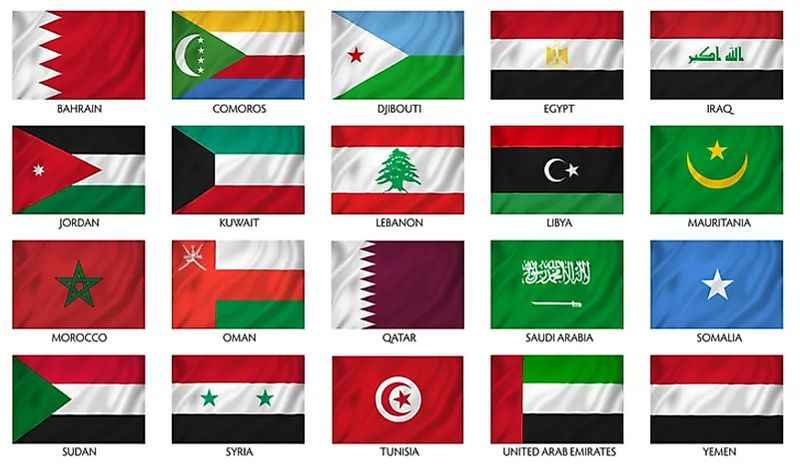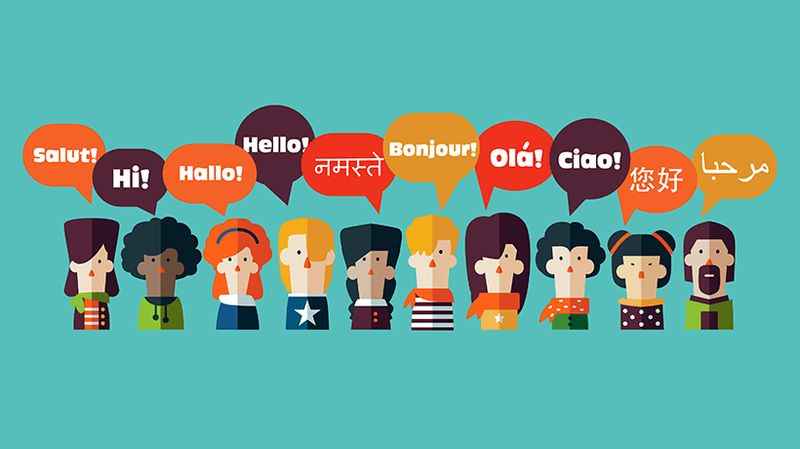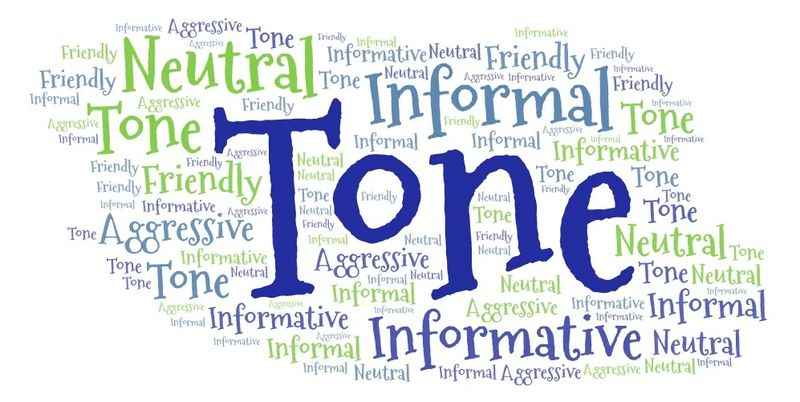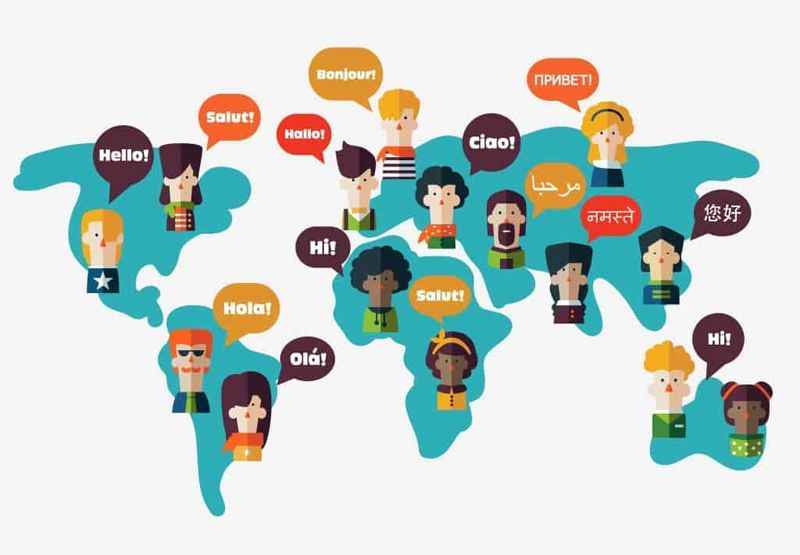28 Easiest and Hardest Languages to Learn for English Speakers

Learning languages is crucial for travelers as it enables them to navigate new environments, connect with locals, and immerse themselves in different cultures.
For native English speakers, the easiest languages to learn tend to be those belonging to the Germanic language family, such as Dutch and Swedish.
Romance languages, including Italian and Spanish, also prove relatively manageable due to their similarity to English. These languages share the Latin alphabet and have phonetic structures, making pronunciation rules fairly straightforward.
In contrast, the hardest languages, like Arabic and Mandarin Chinese, present complex grammar, tonal aspects, and unique writing systems.
However, regardless of difficulty, acquiring even basic language skills facilitates communication, fosters deeper understanding, and enriches travel experiences for English speakers venturing into diverse regions worldwide.
How We Collated This List of Languages
In this post, we have put together a full and comprehensive list of the 28 easiest and hardest languages to learn for English speakers.
In order to put this list together, we took into account the numerous factors which should be considered when deciding whether or not a language is difficult, or easy to learn.
These include, but are not limited to:
- Language types and writing systems
- Grammar and tones
- Physical and cultural differences
You'll find all of this straight after the list!
The easiest languages for native English speakers to learn
As a native English speaker, you will likely get on well with a language that uses the same alphabet as you.
1. Spanish (480 - 600 hours)

The Spanish language is phonetic (meaning the spelling tells you the pronunciation of the word).
This makes learning new vocabulary much easier because the letters are ones that you are already familiar with and you can figure out how to pronounce something with relative ease.
In terms of learning hours, it is thought that it takes you around 575 to 600 hours to learn Spanish to an intermediate level (this is more than enough to converse fluently in the language). However, it will take considerably less time to learn conversational Spanish.
Resources for learning Spanish are also very easy to come by since it is so widely spoken all over the world. It is the official language in 21 different countries!
You may even know some Spanish from high school, meaning you have some basic knowledge to build upon. Oh, and it is also a Romance language, meaning it sounds oh-so-romantic.
2. Dutch (575 - 600 hours)

Dutch is one of the most similar Germanic languages to English, so it is a great one to learn for native English speakers. There are many similar words and overlaps between the two languages, and many of our favorite English words are derived from the Dutch language.
This is because the Dutch were some of the first colonizers of the States. For this reason, they have had a lot of influence on English, particularly American English.
For example, the word ‘frolic’ meaning to play and move around cheerfully (e.g. they frolicked in a field on a warm summer’s day) comes from the Dutch word ‘vrolijk’ which means happy and cheerful.
Also, ‘waffle’, those delicious breakfast-dessert foods, comes from the Dutch ‘wafel’.
3. French (575 - 600 hours)

French is a language that has many similarities to English, and they share a large number of cognates.
Cognates are when a similar-sounding word has an identical meaning. An example of this is 'musique', French for 'music'. This is just one of many cognates that the two languages share.
As well as looking and sounding similar, there are masses of resources out there to help you learn French, and it is spoken widely around the world. There are dialects of French even here in the States and of course, in Canada. Creole, Haitian, and Louisianan are derived from the French language.
And what better excuse to go to Paris and brush up on your French skills whilst you sip coffee and eat croissants?
Check out our list of the best apps to learn French to get started.
4. Portuguese (575 - 600 hours)

As one of the Romance languages, Portuguese is certainly very beautiful. Some people even think it is one of the sexiest languages in the world.
There is a lot of overlap between Portuguese and English as they share many cognates. It is similar in many ways to other languages that native English speakers find easier to learn, such as Spanish and French.
The word order, syntax, and structure of Portuguese when writing and speaking are similar to English and other Romance languages. This makes it easier to get to grips with the language if you already have prior knowledge of any of the other Romance languages.
They use nasal sounds which can be a little bit more tricky to master, but given the wide variety of resources out there, it is a modestly easy language to learn.
5. Italian (575 - 600 hours)

Italian is yet another beautiful language, much like Portuguese and the other Romance languages.
Depending on where in the States you are, you may find that you are surrounded by Italian speakers thanks to the mass Italian immigration to places such as New York in the late 1800s and early 1900s. This has meant that Italian culture and the language have stayed very much alive in these places.
This beautiful language shares many similarities with English in terms of cognates and sentence structure. The rhythm of Italian when you are in a conversation also makes it a little easier to grasp for beginners.
Of course, you also have the masses of Italian words that the English language has borrowed, such as pizza, pizzeria, stiletto, umbrella, and even words like dilemma and ditto!
6. Afrikaans (575 - 600 hours)

Afrikaans is the native language of South Africa and is widely spoken all over the country.
You may think, “How will that be similar to English, it’s on a different continent altogether?” but actually, Afrikaans is derived from none other than the Dutch language, and we all know how similar Dutch is to English.
Afrikaans is a beautiful language that is surprisingly easy to learn for native English speakers.
It has Dutch at its core but it is also intertwined with other dialects and indigenous languages from Africa. There are some shared cognates such as ‘ja’ which means ‘yes’ and ‘veld’ which means ‘field’.
Spellings are also relatively simple, with many words being pronounced how they are spelled. There are also fewer singular and noun genders to learn than in other languages, which makes it easier to learn.
7. Norwegian (575 - 600 hours)

Norwegian is another Germanic language just like English and so it is relatively easy to get to grips with as a native English speaker.
There are many shared cognates between the two languages, making the words easy to recognize and pronounce, as well as having simple ways of creating tenses and possessives.
These grammatical constructs are often difficult to grasp for many languages but the simplicity of Norwegian grammar makes it a little easier.
Some shared cognates include ‘katt’ which of course means ‘cat’, ‘busk’ which means ‘bush’, and our personal favorite (because it is so simple but looks so much more pleasing to the eye than our boring spelling) ‘snø’ which means ‘snow’.
8. Swedish (575 - 600 hours)

Similar in many ways to Norwegian, Swedish is yet another Germanic language that is a little simpler for native English speakers to learn.
Obviously, foreign languages require a lot of work. Like Norwegian, it shares many different cognates with the English language, and pronunciation can be guessed relatively easily when you look at the spelling of certain words.
There is some memorization needed of their verb-forming rules and their articles.
However, when you have that down, the rest will come relatively easily, especially since there are so few of them (no, really! The only verb ending that needs to be used is -är!).
9. Romanian (575 - 600 hours)

Surprisingly, another relatively easy language for native English speakers to get to grips with is Romanian. As another Romance language, it is accessible to English speakers.
The Romanian language is a beautiful amalgamation of Russian and Italian sounds, resembling each of them in different ways. This is a widely spoken language in Balkan.
First and foremost, it is a Romance language, but you cannot deny its Slavic influences, especially when you consider that Romanian once used the Cyrillic script.
Nowadays, Latin script is used, which is why native English speakers find it a little easier. Because of its Latin roots, Romanian does share some cognates with the English language, and because of its phonetic form, pronunciations are easier to get to grips with.
10. Esperanto (575 - 600 hours)

Esperanto is a relatively modern foreign language, as far as languages go. It was designed to be the universal language that everyone could learn and use to communicate.
However, Esperanto is not a widely spoken language, despite it being relatively easy for all speakers to learn, regardless of their native language.
It was created by a Polish man in the late 1880s to make a phonetic language that would be predictable and easy to understand.
Resources for Esperanto are sparse compared to other languages on this list. But its simplicity warrants an inclusion. It is thought that the language may begin to rise in popularity, though, since it is featured on the popular language immersion app, Duolingo.
11. German (750 hours)

Up until now, all the languages we have discussed have had estimated learning times of 600 hours or less. This is a rough estimate, and depends on various factors, such as whether you are learning in the classroom or learning from home.
The German language is thought to take slightly longer to learn than the previous languages, but it is still considered one of the easiest languages to learn for English speakers.
German has masculine, feminine, and neutral nouns to learn, along with conjugating verbs and a syntax that must be followed, or else the meaning can be lost.
Pronunciation and spelling are, on the whole, much simpler to learn, and there are also many shared cognates such as ‘mutter’ which is ‘mother’, and ‘kaffee’ which is ‘coffee’. There are plenty of German language resources available online.
12. Swahili (900 hours)

This toneless African language is thought to be one of the easier African languages for native English speakers to learn. This may be because it is influenced in many ways by English and some of the more familiar Romance languages.
A large portion of its vocabulary comes from Arabic, meaning that will be the main hurdle for non-native speakers to overcome.
However, if you are looking for a modest challenge then Swahili is a great language choice for you. Swahili does share some cognates with the English language such as ‘gereji’ which means ‘garage’ and ‘friji’ which means ‘fridge'.
There is also a welcome lack of verb conjugation, which is great news for learners, especially since this means that the sentence structure stays simple and short.
13. Indonesian (900 hours)

Indonesian is another language that is modestly easy for a willing learner who speaks English natively to pick up. The reason it is so simple to pick up is because of the similarities it shares with English.
Sure, it is a little more difficult because it takes around 900 hours, but the alphabet is Latin script, meaning it is something you will be used to, and the words are phonetic meaning they are said how they are spelled.
As if that wasn’t enough, there are also no tones used in the Indonesian language, so you will not have a difficult extra element to learn.
14. Welsh (1040 hours)

Welsh, the official language of Wales, is a beautiful ancient language spoken by around 29% of the population of Wales. Welsh is a Celtic language and does not bear a relation to English, despite the proximity of Wales to England.
Welsh is a reasonably difficult language to get to grips with for native English speakers, even those English speakers who have lived in Wales their entire lives!
That being said, it is doable and there are a wealth of resources out there if you choose to learn this beautiful, song-like language.
Welsh is full of mutations and consonants that are unfamiliar to an English speaker, but with some memorization and an eagerness to learn, it is certainly possible.
The Hardest Languages for Native English Speakers to Learn
Now that we have covered Germanic and Romance languages, let's look at the tough nuts to crack, including some Scandinavian languages.
1. Icelandic (1100 hours)

Iceland is known to have some pretty difficult words to pronounce, from place names to everyday words. Many of their words are very long with unfamiliar letters and letter sounds such as Þ and Ð.
As a country, Iceland is relatively cut off from other places and so they have been able to retain some of their traditional language and grammar rules.
For example, the noun system is different from most other languages you may have heard of since it has three genders and two numbers. To learn Icelandic you must be prepared to study, memorize rules, and really put in the work. This makes it a very unique language to write, speak and hear.
Nevertheless, the language is a beautiful one, steeped in history. Furthermore, whilst it is known to be difficult to learn and takes a long time, the result makes it worthwhile.
2. Persian (1100 hours)

Persian is most likely known to you under one of the names of its dialects. For example, it is spoken in Iran and called Farsi. In Afghanistan, it is called Dari, and in Uzbekistan and Tajikistan, it is known as Tajik.
Persian is, first and foremost, an Indo-European language and so this makes it a little similar to English.
However, in general, it is much more difficult than other Indo-European languages because it uses a different alphabet or script system. The Persian language uses the Arabic script, something that native English speakers are unfamiliar with.
They also write right to left, which is very different from English writing.
There are also no capital letters in Persian writing, making it difficult to decipher as an English speaker.
That being said, we do have the Persian language to thank for many words that we use in English such as kiosk and bazaar, so you may well find some similarities within this beautiful language!
3. Georgian (1100 hours)

Georgian is a language that is very unique as it has its own script. You would not be alone in assuming that it would be a Slavic language given its proximity to Russia and other Slavic countries.
However, the language family it belongs to is the relatively small Kartvelian. Georgian script is unicase, meaning there are no capital letters and it runs from left to right.
There are a number of different dialects of Georgian, depending on where you are speaking it, but the most common is the one spoken in Georgia itself.
Many of their words feature many consonants, as well as beginning with two consonants which can be jarring for a native English speaker. Nevertheless, Georgian is a beautiful language, particularly when listening to the music of the country.
4. Russian (1100 hours)

Russian is the largest of all of the languages in the Slavic family and is spoken widely in the country and around the world. Nevertheless, it is difficult for a native English speaker to learn Russian.
The main reason for this is because of the use of the Cyrillic script. Russian is closely related to the Serbian language. Learners need to learn a whole new alphabet and character system to understand Russian.
In addition to this, they also feature ‘hard’ and _‘_soft’ sounds for each of the consonants, meaning that pronunciation can be difficult to get to grips with. The stress placed upon words and sounds is also important. A Russian word could look identical to another when it is written down but may have two very different meanings.
An example of this is the Russian words замо́к and за́мок. These two words look almost identical, but notice the very small differences between the а and the о́. These minuscule differences can transform the meaning entirely. The first of the two means ‘a lock’ whereas the second means ‘a castle’.
5. Polish (1100 hours)

Polish is a member of the language family known as the Slavic family, meaning it is similar to Russian. However, a welcome difference between Polish and other Slavic languages is the fact that it uses an alphabet that you will be more familiar with the Latin script.
In their Latin script, they also include an additional nine letters, which look a lot like letters you are familiar with, but still require memorization and learning in order to fully understand and use them. These letters are ą, ć, ę, ł, ń, ó, ś, ź and ż.
These new letters and the fact that Polish words also have more consonants than English words can mean that pronunciations are very difficult to grasp for a beginner, and can make spelling difficult.
Their words also tend to have more syllables than English words. For example, the word for ‘ruthless’ has five syllables and an astounding number of hard consonants: ‘Bezwzględny’.
Nevertheless, with lots of practice and a desire to learn, it is more than achievable.
6. Finnish (1100 hours)

Finnish is an interesting language to feature on this list because most people may assume that it would belong to the Indo-European family. You might be surprised to find out that Finnish is a very unique language.
It has no cognates or loan words, and you are highly unlikely to draw similarities between Finnish and English. Finnish belongs to the Uralic family, just like Hungarian and Sami (the indigenous language of Lapland).
The grammar used in the Finnish language is complex, with around 15 grammatical cases and countless word endings. The Finnish language often uses just one word to say a whole sentence, which can be confusing for those used to the complex sentences of the English language.
7. Gaelic (1100 hours)

Like Welsh, Gaelic is another language that comes from the UK. However, it could not be further from English. There is Scottish Gaelic and Irish Gaelic.
The family these languages belong to are the Goidelic languages which, in turn, makes them a part of the Brittonic language family, like Welsh.
They do use Latin script, but there are many grammatical cases that can make it much more complex to get to grips with than English. The sounds they use are also very different from English and can leave you feeling tongue-tied.
On the bright side, the spellings are largely phonetic, and once you have learned the grammar rules the language becomes easier.
8. Hungarian (1100 hours)

Hungarian is notoriously difficult to learn. Hungarian belongs to the Uralic language family. Members of this language family tend to have complicated grammatical rules and more than double the number of vowels that the English language uses.
There are a whole 35 different cases in this language; they also follow the unfamiliar concept of ‘vowel harmonies’. This is where to keep the sounds in harmony, suffixes are added to words.
However, something that may soothe the pain of all these complex grammar rules is the fact that in Hungarian there are only three verb tenses to learn: the past, the present, and the future.
9. Turkish (1100 hours)

Whilst Turkish has used the Latin script for almost 100 years, it is still a very difficult language to grasp for English speakers because of the sheer volume of learning and memorization of grammatical rules required.
The Turkish language features an unfathomable 30 verb tenses compared to the 12 in English.
As if that wasn’t hard enough, they also use 6 noun cases and make use of vowel harmony, which is where vowels can sometimes shift in order to sound harmonious. Because of this, many words can change meaning entirely when a suffix is added!
10. Mandarin Chinese (2200 hours)

Chinese is a very challenging language to learn (whether Mandarin or Cantonese) due to the use of tone and of course the unfamiliar script. The tonal element of this language is perhaps the hardest aspect to get to grips with.
The letters can be learned and memorized, as can pronunciations, but the tone can take a little while for native English speakers to get right, especially if you have no native Mandarin speakers around to hear your tone and correct you if needed.
The language is also full of idioms and homophones which, without prior experience, can also be very confusing.
That being said, it is one of the widest spoken languages in the world, with over 900 million people speaking it daily. So if that is not enough motivation to learn we don’t know what is! There are many Mandarin Chinese language resources available online.
11. Hindi (2200 hours)

The Hindi language is a relatively challenging one and takes hours to perfect to even an intermediate level. This is because the grammar, pronunciation, and even writing of Hindi is very difficult to get to grips with as it is so unfamiliar.
Like the Persian language, Hindi has no capital letters, which in itself is very unfamiliar to native English speakers.
As well as this, the grammar rules are different from what we may be used to, as they follow the Subject Object Verb writing and speaking order. The script that they use (Devanagari) is vastly different from Latin and even Arabic script.
It has 47 different characters that must all be learned before you can fully get to grips with the language. On the bright side, it is phonetic, which means it is spelled how it is said and vice-versa.
12. Arabic (2200 hours)

We have mentioned Arabic many times already as the Arabic script is used in many different languages. However, did you know that Arabic is also a language in its own right?
There are over 30 varieties of Arabic worldwide. For this reason, it is considered a ‘macro’ language because its reach is vast and extensive.
As you likely expected, Arabic uses Arabic script. This means that in order to learn Arabic you have to learn a whole new bunch of letters and characters. They also read and write right to left, which is unfamiliar for most native English speakers.
The sounds created in the language are challenging for beginners as it is so culturally distanced from what you may be used to.
On the bright side, because it is so widely spoken with many different varieties there is a wealth of resources out there to help you.
13. Korean (2200 hours)

The Korean language has a reputation for being notoriously difficult for a native English speaker to learn. It is a beautiful language from a country steeped in history and, as such, many of the traditional ways of speaking still stand.
For example, the language register used by the speaker depends on who he or she is speaking to. A person of authority will have a different word ending to a normal person when someone is addressing them.
Likewise, some words get added to names as a term of endearment, respect, or politeness. There are some key grammatical rules that must be followed, such as the inclusion of suffixes on words, particularly verbs.
There are also connectors that can make sentences long, meaning they are even more complex to understand and translate.
Then, of course, there is the Korean alphabet and writing system to consider. Korean Hangul characters will need to be learned and memorized when you first begin to study the language. For all its challenges, though, it is a worthwhile language to learn with some interesting conventions.
If you are interested in learning Korean, it is worth looking at the Korean Uncovered language course, part of the Storylearning Language-learning series.
14. Japanese (2200 hours)

The last language on our list is Japanese. This is because Japanese has long been thought to be one of the most difficult languages ever to learn, whether you are native English-speaking or not. This is because of the complex writing systems in Japan.
Yes, that is systems, plural. There are three writing systems, kanji, katakana, and hiragana. It is the former two that are most commonly used.
Kanji is a character-based system with thousands of characters to learn. Over 2000 of them are commonly used, so you need to know at least all of those. This means you will have to work hard to memorize the way words are written.
As you are getting to grips with the writing of the language, you will also need to familiarize yourself with the cultural aspects of the language.
Like Korean, there are many different ways of addressing someone. Politeness is very important in Japan and so this must be demonstrated through language in the way you address people.
Many Japanese language apps teach users the various fascinating aspects of Japanese culture whilst also teaching the Japanese language.
Factors That Influence How ‘Easy’ or ‘Hard’ a Language is to Learn

There are many reasons why certain languages can be easy or hard for an individual to learn.
For example, tonal languages can be difficult for someone who has no prior experience with tonal languages (for example, most of us English speakers).
However, this is not a hard and fast rule, and there are also many other contributing factors.
In this section, we are going to be exploring some of the main reasons why you may find a certain language easy to learn, or indeed very difficult.
This will help you to work out whether a particular language is right for you or whether you may want to start with the one that is more similar to your native language.
Language Types

Many languages are similar to other languages. English, for example, has many similarities to other Germanic languages (think German and Dutch). For this reason, many native English speakers may find that these languages are a little easier to learn than a language such as Chinese Mandarin or Arabic.
That being said, several different factors may affect how easy or difficult a person finds it to learn a specific language.
Some tonal languages may be particularly difficult for English speakers, as this is not something that they are used to. However, someone who has a tonal native language such as Thai may find it easier to learn other tonal languages - an example of this is Vietnamese.
The Writing System

A large part of learning a language is learning how to write it. This can help you practice more and learn it far more quicker.
However, if the writing style is very different from what you are used to then you may well struggle to get to grips with this at first.
Some languages do not use the alphabet as we know it or the same writing system for that matter. By this, we mean some may not use what is known as the Latin alphabet (A, B, C, D, etc.), using the Cyrillic, Arabic, or Kana System (among many others) instead.
Some writing systems require writing from right to left, as opposed to the left-to-right method that Germanic languages (English, German, etc.) use. Obviously, this can be confusing to someone who is new to learning languages.
If the writing style is very different from what you are used to then you may well struggle to get to grips with this at first. This problem is observed among many students, so they often turn to services like Thesis Rush, which helps with all kinds of writing theses, dissertations, or papers.
Services such as Custom Writings can also help with learning, as well as provide assistance with college or university assignments.
Grammar

One important concept that can affect whether a language is learned easily by a native English speaker is the grammatical framework. If the grammar structure of the language you are learning is similar to your native language, it will undoubtedly be easier for you than if it were not.
Many popular world languages have very different grammatical structures to English. These differences include word order differences, tenses, and even the inclusion of gender into language.
This can be difficult for a learner to get used to, especially if it is not something that they have ever come across before.
The language family

Language families are languages that are grouped because they are related in some way through descent. They often descend from the same common parental or ancestral language and can branch off to form many other unique languages.
An example is the large group of languages called the Indo-European language family. This family contains sub-groups of languages, namely the Germanic languages, the Romance languages (Spanish, French, and Portuguese among others), and Balto-Slavic languages (Prussian, Serbian, Russian, Czech, Latvian, and more) to name but a few.
Typically, it is thought to be easier to learn a language that is in your language family or sub-group. This is because there may be similar cognates and some loan words that you will recognize.
You may even find that some of the vocabulary words are easily identifiable because they are similar to words in your native language. In comparison, a language that is not in your language family may be more difficult to get to grips with.
Physical and Cultural distance

How far away the country that the language belongs to (both physically and culturally) can also be an influencing factor in how easy or difficult a language can be to learn.
This is because you have less chance of being able to interact with other speakers as you go about your daily life, and also because the language may incorporate cultural concepts that you are not familiar with.
The Sounds and Tones of the Language

The tones and sounds of a language can have a direct impact on how difficult you find it to learn. Tones are very important in some languages and are used to alter the meaning of the same sound.
Other languages may have unique and new sounds, compared with the sounds you know from your own language and alphabet. Different languages may use breathing and throat noises as part of their words which can be difficult to master for those new to the language.
Ways to Learn a Language Faster

As we highlighted in our introduction (remember that, it seems like ages ago, so you can skip back to the beginning of the article for a refresher if you wish) there are many reasons why a person may want to learn a new language. Ask yourself some questions:
- Why is it important to you that you embark on this learning journey?
- What will help you to persevere even when it starts to get difficult?
These things will help you to stay focused and will motivate you to keep going, even when there are days when the learning is less enjoyable.
Find a Language Partner

As we just mentioned, it can be very rewarding to make a friend who is on the same language-learning journey as you. However, not only is it rewarding to form a friendship in this way, but it can also be beneficial to your learning journey. You and your buddy will be able to help each other.
For example, you may seek out a language teacher who specializes in your chosen language. You could even hire a teacher or tutor for yourself, or attend language classes to help you along with your journey.
Practice Daily

Daily practices will help you to form your language learning into a habit. Even if it is just ten minutes a day, it is enough to keep what you have learned fresh in your mind.
Try one of the countless language learning apps, watch online videos of people teaching the language, or challenge yourself to read a chapter or an article in your chosen language.
You could even try changing the language on your cell phone!
It is no good attempting to learn a language but only practicing once or twice a week. Practice little but often and you will likely find that things stick in your head much faster and more easily. This will boost your confidence and enjoyment of the language, making you want to learn more.
Speak Out Loud

When you are learning a language alone, it can be difficult to find the time to practice speaking it. Especially if you have no one around you who speaks it. Speak aloud to yourself or record yourself doing it using your smartphone, computer, or a recording device.
By doing this you can hear whether you are pronouncing things correctly and will be able to compare them to audio of native speakers. This is especially important if the language you are learning is a tonal one.
Watch Movies and TV and Listen to Music

Yes, we are being serious! One of the best ways that you can learn a language is to fully immerse yourself in all aspects of it, including different types of media in that particular language.
For example, if you are learning Korean, find yourself some Korean movies or TV shows to watch. If you are learning Spanish, get some Spanish music on or tune into a Spanish soap opera.
You can also find some of your favorite movies and shows that you already know well and watch them in another language. Sure, they will likely be dubbed, but it will be extremely beneficial as you will already know what is going on and you will have a chance to hear the language in a familiar setting.
FAQs About the Easiest and Hardest Languages to Learn for English Speakers
Now, let's see some of the most frequently asked questions about languages that are easy and hard to learn for English speakers.
Can English native speakers ever be fluent in Asian languages?
Yes, English native speakers can become fluent in Asian languages with dedicated effort and practice. Although they may face challenges due to differences in grammar, writing systems, and pronunciation, fluency is attainable through consistent study and immersion.
Should you choose a second language based on your native language?
Choosing a second language based on your native language can be beneficial. Languages within the same language family or with similar structures may be easier to learn due to shared vocabulary or grammatical concepts. However, personal interests and cultural connections should also be considered.
How early can kids start learning a second language?
Kids can start learning a second language as early as infancy. Exposing them to languages through songs, games, and interactive activities can foster early language acquisition skills.
Can seniors learn Romance languages?
Absolutely, seniors can learn Romance languages at any age. While language learning may require more time and effort, the cognitive benefits and joy of acquiring new skills are ageless. Patience, consistent practice, and utilizing tailored learning resources can lead to proficiency and enjoyable language acquisition experiences.
Summing Up: Easiest and Hardest Languages to Learn for English Speakers
The most important thing that we want you to take away from this article is that even though some languages may be easier for a native English speaker to learn than others, it does not mean the ‘harder’ languages are out of your reach.
With dedication, motivation, lots of passion, and enthusiasm to learn, you will be able to master any language you want. The only barrier you need to overcome is yourself.
Follow our tips in the section above to help you learn your chosen language a little quicker, and always keep in mind that good things take time. You will have noticed that even the ‘easiest’ languages on this list can take between 575 and 600 hours.
That is a significant amount of time, so make sure to have fun while you learn. There will be times when you feel like giving up, but keep persevering. You will be glad you did when you hold your first conversation in your new language with a native speaker!
If you are interested in learning a new language before you set off on your travels, check out the link below to access a wide range of effective language courses.







